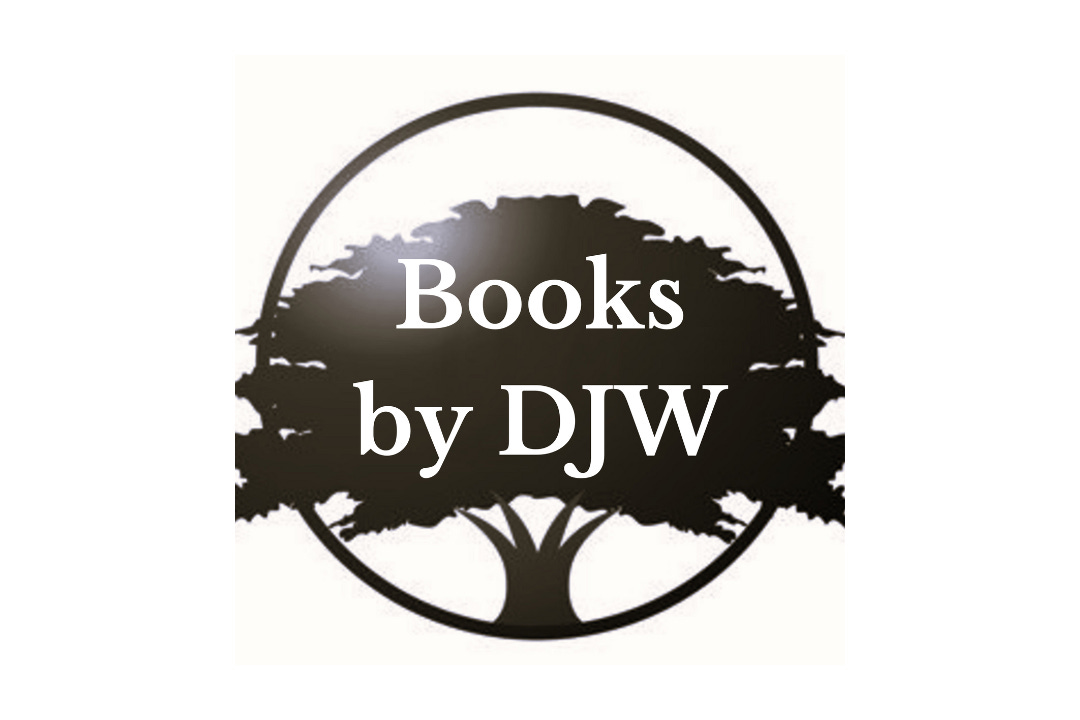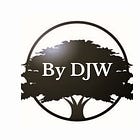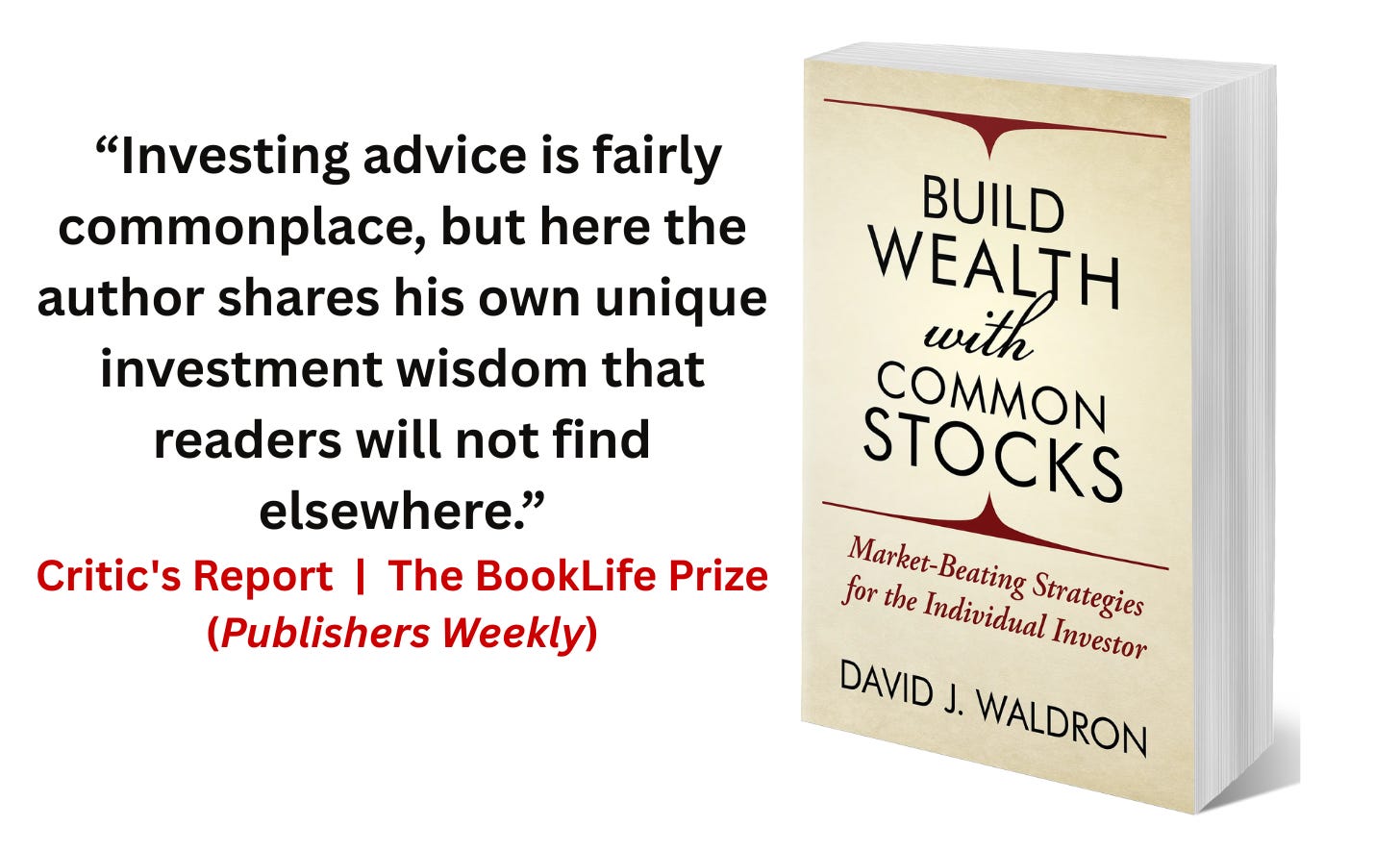Chapter Nine: Create Wealth Through Total Return
Revised and updated | Build Wealth with Common Stocks: Market-Beating Strategies for the Individual Investor
Audio voiceover:
Substack’s AI-generated voiceover is available from “Books By David J. Waldron.” To access it, open the chapter in the Substack app. Feel free to share your thoughts in the comments or via direct message. I will use AI to clone my voice for the book’s official audiobook release.
Learn more about audio voiceovers:
https://davidjwaldronbooks.substack.com/p/audio
Haven’t read the previous chapters? Find them here on the book’s webpages:
Books by DJW Author Website
https://davidjwaldronbooks.substack.com/p/build-wealth-with-common-stocks
Quality Value Investing Newsletter
https://davidjwaldron.substack.com/p/build-wealth-with-common-socks
Chapter Nine
Create Wealth Through Total Return
Focusing only on dividend yields and ignoring growth leads to poor results. Build wealth through total-return investing — capital gains plus income — so that, in retirement, you can enjoy your bucket list instead of depending on higher dividend payouts.
I rebalance our family portfolio about once a year — by adjusting the holdings to maintain asset allocation — treating it as a total-return vehicle rather than just income. Remember, dividends offer short-term compensation while waiting for the stock’s long-term capital appreciation.
This chapter explains why and how total return is the best approach for the thoughtful, disciplined, and patient investor.
Practice Total-Return Investing
Quality dividend value investing, or total return, concentrates on dividend yields below 5 percent, a range where you find strong companies paying significantly less than 100 percent of earnings in dividends, also known as the payout ratio, discussed later in this chapter.
Many companies with 6 to 10 percent or higher-yielding shares must increase their dividend rates, or the stock prices need to decline, or both, for the dividend yields to stay high or rise. These are risky scenarios.
It is uncommon for popular trends to serve as solutions for struggling investors. Time and again, each investment fad proves damaging to portfolios. As discussed in Part II, Chapter Twelve, the prudent investor favors companies where the average of trailing dividend yields plus the yields on earnings and free cash flow surpasses the current Ten-Year Treasury rate. Still, we cannot predict the future with certainty and should not do so at the risk of our portfolio and the family it supports.
Although safer than high-yield dividend or non-dividend growth investing, dividend-paying value investing still shares the inherent risks of the stock market. All dividend stocks face the possibility of unexpected rate reductions or suspensions by the company’s board of directors. The dividend-paying common shares of quality companies generally tend to be less susceptible to ticker price volatility and market liquidity issues than high-yield dividend or non-dividend growth stocks.
All the Rage for the Wrong Reasons
High-yield dividend stocks were on investors’ minds for higher payouts during the low-interest-rate environment of the post-Great Recession bull market.
Many popular financial subscription and media articles focus on the high-yield trend. History shows that the crowd is almost always wrong about fads and favorites. High-yield dividend stocks — defined as those with yields of 6 percent or more on common shares — are no different, and that’s why I remain consistently bearish.
Along with high returns, looming risky headwinds, and questionable underlying fundamentals, just ask the victims of the high-yield junk bond bubble in the 1980s. Perhaps the recent bull market and its high-yield equity opportunities are different; the perma bulls rejoice.
The junk bond craze resurfaced during the recent bull market through high-yield dividend stocks. History shows how the previous bubble burst during the stock market crash of 1987. This time, instead of relying on leveraged mergers and acquisitions when available capital was limited, high-yield equities fueled risky bets as retail investors and advisors chased bigger returns to boost returns from underfunded retirement account balances.
Defining high-yield equity is subjective and broad. Therefore, this chapter defines high-yield dividend stocks as publicly traded equities that pay at least three times the Ten-Year Treasury rate, which was 1.92 percent as of December 31, 2019. Consider 6 percent or higher as the ideal threshold for high-yield equity. In the context of the COVID-19 pandemic, consider the sub-1 percent rates of 2020 as an anomaly.
An inevitable cyclical decline in the overall stock market ultimately impacts the capital invested by millions of retail investors, who focus on high-yield dividend stocks, such as business development companies (BDCs), master limited partnerships (MLPs), and real estate investment trusts (REITs). Wise investors never buy stocks solely based on market hype or high dividend yields.
His Neighbor Yelled, ‘Buy the Yield’
For some background, high-yield dividend investing caught my attention earlier in the post-Great Recession bull market, thanks to a retired family member.
Acting on a tip from a neighbor — mistake number one — he transferred a significant amount of capital from a well-known, blue-chip equity REIT to the unpriced, non-marketable security of a high-yielding hotel REIT.
The REIT staple was sold to generate capital and ended up as a seven-bagger stock, with an average annual dividend range of approximately 4 to 5 percent in the following years. As promised, the unpriced hotel REIT paid significantly higher dividends, and the security went public in due course at roughly the projected initial cost per share.
On the verge of the COVID-19 coronavirus correction, the publicly traded hotel REIT’s price had fallen 15 percent since the IPO, although it continued to pay healthy dividends. An overall insufficient result, as it amounted to a no-bagger, contrasting sharply with the seven times return of the blue-chip REIT sold to raise capital for the high-yield, unpriced security.
The misfortune of the family member illustrates the risks associated with unpriced securities. Whether priced or not, it was some brokers’ practice to persuade retirees to sell below 5 percent stable yielders for the 6 to 10 percent plus yields of risky equities. Once again, caveat emptor applies.
The allure of high yields on a stock often overshadows the essential due diligence needed to determine if the company is stable enough to justify the yield through capital investments and shareholder returns from a well-managed operation. Do we prefer to own a quality 4 percent yielder with a compounded average capital gain of 6 percent annually, or a high-risk stock yielding 10 percent, even if it averages a negative 5 percent annual capital loss?
In the first case, the value investor averages a gain of over 10 percent annually. In contrast, the high-yield enthusiast settles for a modest 5 percent average annual total return.
Some retirees might have had the opposite experience, investing in high-yield stocks that delivered double-digit total returns each year during the recent bull market. Like a wild party, this bubble burst when the coronavirus pandemic hit unexpectedly. High dividend investors who believe they can time the perfect exit are sailing on the proverbial ship of fools.
Chasing Yield: A Guide to Risky Investments
Many top financial advisors, bloggers, and investors concentrate their research and investment efforts on high-yield dividend strategies, such as REITs, BDCs, and other closed-end funds (CEFs), as well as energy transfer partnerships and preferred stocks.
For those wondering why the book is partial to common shares, preferred stock is an equity instrument that functions like a glorified bond with an emphasis on dividends. Although preferred shareholders do not have voting rights, they receive a portion of the earnings before the common shareholders. If you are committed to owning small slices of high-quality companies, there’s less concern about waiting for payment. Therefore, consider the secondary dividend, the first voting rights — and, more importantly — the capital gains of the common shares of strong, enduring companies.
Some well-crafted story headlines and marketing pitches cast a positive spin on the paradox of ‘safe,’ high-yielding investments. Such absurdity is akin to fishing for sushi-grade salmon in a crystal clear river known as toxic from a colorless pollutant.
As expected, these pundits remind me of what I missed, overlooked, and stumbled over in my analysis, challenging some of my assumptions and conclusions. Although professional debate is encouraged and welcomed, my main point remains that investors are more focused on dividends than on enterprise quality with high-yield stocks. Still, if a careful trading strategy prioritizes income over capital gains, so be it, with cautious best wishes.
Remember, dividend rates adjust on a monthly, quarterly, or annual basis based on board-approved payouts, and the associated yields fluctuate daily due to changes in the stock price. The idea of dividend payouts follows a simple principle in the basic economics of the price/yield relationship, whether for bonds or stocks. When the price increases, the yield decreases, and vice versa.
The Alternative High-Yield Dividend Strategy
Focus on a stock holding’s yield based on cost, rather than pursuing current dividend payouts.
The return on cost shows the yield of the current dividend rate compared to the cost basis of the common shares. For example, as of this book’s September 2025 update, the yield on cost for each of the top five holdings of The Model Portfolio was much higher than the current forward yield.
Yield on Cost of The Model Portfolio’s Top Five Holdings
Company (Symbol) | Dividend Rate | Cost Basis | Forward Yield | Yield-on-Cost
Union Pacific Corp (UNP) | $5.52 | $28.45 | 2.55% | 19.40%DICK’S Sporting Goods Inc (DKS | $4.85 | $27.93 | 2.20% | 17.36%Microsoft Corp (MSFT) | $3.32 | $142.71 | 0.67% | 16.57%
Penske Automotive Group Inc (PAG) | $5.28 | $37.81 | 2.87% | 13.96%Williams-Sonoma Inc (WSM) | $2.64 | $21.28 | 1.30% | 12.41%Source: The Model Portfolio at davidjwaldron.substack.com as of the market close on September 10, 2025.
Table Key
Dividend Rate — Trailing one-year dividend payout in $US.
Cost Basis — The original cost of each common share of stock.*
Forward Yield — Dividend rate divided by closing share price.
Yield-on-Cost — Dividend rate divided by cost basis per share.
*Adjusted for stock splits and dividends.
Payout Ratio
The payout ratio is the percentage of earnings paid out as dividends to shareholders.
A lower payout ratio is better than a higher one; a rate above 100 percent means the company is paying out more in dividends than it earns in net income. Laws and regulations require many of the high-payout players, like REITs and BDCs, to distribute up to 90 percent of their taxable income to shareholders. I reviewed high-yield dividend stocks, and over 50 percent of the companies listed had payout ratios exceeding 100 percent. Where does the cash flow come from to support this level of payout?
The concern is whether the excess payout originates from the balance sheet or the cash flow statement, which could harm the financial stability of the operation. Instead of pursuing risky, high-yield dividends, calculate the yield on cost for your current holdings with low payout ratios. The five holdings of The Model Portfolio, as shown in the preceding yield on cost table, each had payout ratios well below 60 percent.
Look for companies that pay sustainable and predictable dividends to shareholders, as these payments will keep you rewarded in the short term. At the same time, patiently wait for the stock price to appreciate over the long term. Own a quality company with a reasonable payout ratio, and the dividend yield will take care of itself.
Despite the popularity of high-yield investments, I recommend owning quality companies represented by dividend-paying common stocks listed on major exchanges, buying only when trading at attractive prices. In retirement, the dividend itself provides income. And when measured by the yield on cost, your low payout ratio dividend may be offering a high yield worth holding.
Beat the Market or Join It
The do-it-yourself, active method of building wealth with common stocks focuses on outperforming in every market cycle, whether it’s bullish, bearish, or range-bound.
Among my favorite individual investors was my wife’s Aunt Beverly. She bought and held stocks, storing the share certificates in a bank vault and never selling. Her broker earned minimal fees from Beverly’s lifelong strategy, and some of her holdings had become worthless. Nonetheless, by the end of her life, her sizeable portfolio taught a powerful lesson about the potential benefits of buying and holding shares of great companies and enjoying the compound growth of capital and dividends.
A gentle reminder that it’s possible to outperform the S&P 500 over a long period. For a retiree, the priority should perhaps be to hold stable, blue-chip companies that provide secure cash flows from dividends exceeding the current inflation rate. Remember, instead of serving the market — as many investors do — let the market serve you.
Model the portfolios of successful retail investors, such as Aunt Beverly, who remind us that the total return approach yields some of the best performances in common stock investing. As low-fee generators, these portfolios are hard to find on Wall Street. Such practices push us to build portfolios ourselves with limited capital, though at lower costs and less risk.
CHAPTER NINE SUMMARY
On Creating Wealth from Total-Return Value Investing
High-yield dividend stocks and dividend growth investing were all the rage in the post-Great Recession bull market for the wrong reasons.
The patient, disciplined, and thoughtful investor is committed to dividend value investing, aiming for total return through both capital gains and dividend income.
The first mistake many investors make is trusting a tip from a broker, financial writer, or even a neighbor. Do your research.
A practical alternative to high-yield investing is to assess the yield-on-cost of quality companies with low payout ratios that are already in your portfolio.
Instead of chasing yield, focus on buying quality at a fair price and, like Aunt Beverly, hold onto it for as long as you can, maybe forever. Any dividend payouts are a welcome bonus.
This updated chapter is copyrighted 2021 and 2025 by David J. Waldron. All rights are reserved worldwide.
Next in Build Wealth with Common Stocks | Chapter Ten: Embrace an Enduring Market Truth
Universal links allow you to preview or purchase David’s published print or ebooks — each available globally at your preferred online bookstores — with one or two clicks, brought to you by our trusted partner, BookFunnel.
Share the “Books By David J. Waldron” author website with your network to earn credits for a premium subscription that provides full-text and audio access to all of David’s manuscripts and updated chapters of his published self-help books.







